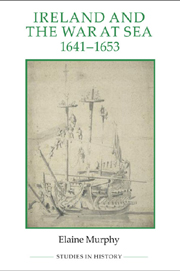Book contents
- Frontmatter
- Contents
- List of figures, maps and tables
- Acknowledgements
- Abbreviations
- Glossary
- Map 1 Ireland, 1641–9: principal ports and locations
- Map 2 The British Isles, 1641–9: principal ports and locations
- Map 3 The British Isles and Europe, 1641–9: principal ports and locations
- Introduction
- PART I The War at Sea, 1651–1653
- Part II Navies and the Conduct of the War at Sea
- 5 A job done well enough? The parliamentary naval effort in Ireland, 1641–1653
- 6 For the defence of the coasts of this realm: the confederate naval effort, 1641–1653
- 7 Fighting the war at sea in Ireland, 1641–1653
- Conclusion
- Appendices
- Bibliography
- General index
- Index of ships
7 - Fighting the war at sea in Ireland, 1641–1653
from Part II - Navies and the Conduct of the War at Sea
Published online by Cambridge University Press: 05 April 2013
- Frontmatter
- Contents
- List of figures, maps and tables
- Acknowledgements
- Abbreviations
- Glossary
- Map 1 Ireland, 1641–9: principal ports and locations
- Map 2 The British Isles, 1641–9: principal ports and locations
- Map 3 The British Isles and Europe, 1641–9: principal ports and locations
- Introduction
- PART I The War at Sea, 1651–1653
- Part II Navies and the Conduct of the War at Sea
- 5 A job done well enough? The parliamentary naval effort in Ireland, 1641–1653
- 6 For the defence of the coasts of this realm: the confederate naval effort, 1641–1653
- 7 Fighting the war at sea in Ireland, 1641–1653
- Conclusion
- Appendices
- Bibliography
- General index
- Index of ships
Summary
The war fought on the Irish seaboard in the 1640s and 1650s has received relatively little attention from historians. In many respects this is easy to understand: no battles took place between opposing fleets in the seas around Ireland, compared to the numerous large-scale battles and sieges as well as a range of more minor engagements on land. At sea the fighting was small-scale, and descriptions of it often bland and uninformative, offering little insight into the tactics or methods of fighting employed by the ships involved. Joseph Content, captain of the highly successful confederate privateer the St Peter of Waterford, deposed in July 1649 that ‘He tooke about thirtie sixe vessels, moste of them English, some whereof hee only pillaged and others havinge only ballaste hee lette goe’. This rather vague statement provides little information on how his frigate actually managed to capture so many prizes at sea. Notwithstanding the shortage of evidence, however, it is possible by bringing together a wide range of archival sources to explore some aspects of the conduct of the war on the Irish coast, in particular what happened when vessels from opposing sides actually encountered each other at sea.
Naval warfare in the seventeenth century
Studies of the tactics used by early modern naval forces have focused on three main issues: the development of the line ahead formation, the decline of close combat and boarding and the rise of naval gunnery.
- Type
- Chapter
- Information
- Ireland and the War at Sea, 1641–1653 , pp. 125 - 142Publisher: Boydell & BrewerPrint publication year: 2012



